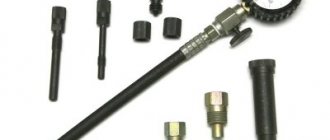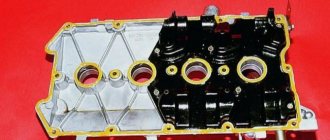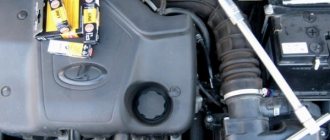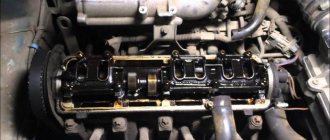What should be the compression on an 8-valve VAZ-2110
Many VAZ-2110 owners wonder why their cars have different compression? Typically, compression is injected as the piston moves from the bottom to the top. In this case, a certain pressure is created in the cylinder. Good compression can only happen if all gaskets, pistons, rings or valves are in good condition. It is because of these elements that the air in the system is compressed.
Compression test for 8 valve engine
Video instructions for measuring compression
on a
VAZ
with a 16-valve engine. Subscribe to our. 2) Spray the hole with oil.
3) We re-measure the compression. If after repeated measurements the compression has increased, then the rings are worn out. If the result is the same, then the valves are burned or stuck. The pinch valves can be adjusted and the combustion valves can be changed.
Excellent compression in the engine. Main reasons. Don't be happy if your compression readings disappear, it doesn't mean your engine is running strong.
As stated above, the ideal compression for an 8 valve engine is 14-14-14-14. If your compression is higher than these numbers, then it's time to think about faults. High compression can damage the piston walls and knock out the cylinders. The following are the main causes of high/high compression: High compression is created due to excess oil in the cylinder, so it is sometimes called oil compression 2) PPPPP The oil rings have been worn or padded. (In such cases, oil consumption is inevitable.) Check the oil level: Also pay attention to starting the engine after a long period of parking, such as in the morning.
If you consume oil in the engine, the exhaust will be black). 3) PPPPP There may be a deposit in the cylinders. Try to get rid of it by deleting it.
If you are experiencing the problems described below, it is possible, BUT NOT FACT, that your engine has insufficient compression. Therefore, you need to pay attention not to the signs, but simply measure the compression
. 2) PPPPPP High fuel consumption (How to increase engine compression in other ways? There are several options for increasing compression without repair.
These operations in no way guarantee compression growth, but you can try. But it is still recommended to repair the fault with a mechanical restoration to solve the problem: throw away the rings or replace the valves. I tried this myself, it really works. The valve may be jammed so that it does not close, causing compressed air to leak. 2) PPPPP Removes carbon deposits and excess oil from the cylinder. P Can only work with stuck rings, if the valves do not perform this operation, there is no point.
Many VAZ-2110 owners wonder why their cars have different compression? Typically, compression is injected as the piston moves from the bottom to the top. In this case, a certain pressure is created in the cylinder. Good compression can only happen if all gaskets, pistons, rings or valves are in good condition. It is because of these elements that the air in the system is compressed.
Normal compression on a VAZ-2110
Typically, compression is checked using a special device. It is recommended to do this regularly.
This helps determine the degree of wear of the motor and rings, as well as the piston itself. Normal cylinder pressure on a VAZ-2110 with 8 valves should be from 10 to 12 atmospheres .
Normal compression in the cylinder.
It is also worth noting that sometimes the pressure in different cylinders may differ . If it is 0.5-0.7 atmospheres , then this phenomenon is normal and should not cause concern.
Abnormal compression
This happens when there are more or less atmospheres in the cylinder than in others.
Such an engine will not be able to operate normally. He absolutely needs to carry out repairs.
Causes
Burnout of the gasket between the block and the head is a fairly common defect.
There can be many reasons why there may be a difference in compression. Experts highlight the main ones. This:
- The head and block gaskets are burnt out. It just needs to be changed.
- The head is not tightened. The gasket may burn out here.
- The rings don't hold. The reason here is the wear of the rings or their breakage. If the pressure drops in one cylinder, this often indicates a broken ring. This will require piston repair.
- Coked rings. They will need to be cleaned.
- Block wear. Happens rarely.
- Motor overheating.
- The piston is broken or burnt out. There is no compression at all.
- Valves not adjusted.
conclusions
Knowing these points, you should not worry about the difference in compression in different cylinders on a VAZ-2110, if it is small. When the standard exceeds acceptable values, repairs will be required .
The very concept of “compression” denotes the amount of pressure that the engine piston develops at maximum compression of the working mixture, that is, when it is at its lowest point. The higher this parameter, the higher the temperature the fuel-air mixture will burn, which means its consumption will decrease and the overall efficiency of the engine will increase.
Read more: UAZ Patriot error R 04
The compression of the VAZ 2114, in fact, like the compression on any other car, depends on the following indicators:
- on the size of the clearance between the cylinder walls and the valves;
- on the volume of the incoming mixture, which, in turn, depends on the position of the throttle valve and the characteristics of the air filter;
- from the current engine temperature.
In turn, the size of the gaps between the cylinders and the elements of the piston group can also have a number of reasons:
- high degree of wear or burning of their walls;
- incorrectly set clearance between the cylinder walls and the valves;
- the entry of liquid gasoline into the cylinder (not in the form of a mixture), which causes the oil to be washed away from the walls and the clearance to increase.
Repair
As can be seen from the above, there are many reasons for different compression in the cylinders. In this case, it is not always possible to carry out repairs yourself, especially if you do not have the skills. In this case, it is recommended to contact specialists at a service station.
Traditional methods of increasing compression
It is noted that the methods described below cannot be a 100% guarantee that compression in the cylinders will increase.
- Buy a quality valve cleaning fluid and pour it into the oil.
- Pour this liquid into the cylinders overnight.
Compression in the cylinders of a VAZ 2110, how to check?
Compression measurement in VAZ 2110 cylinders
The pressure created in the engine cylinders is otherwise called compression. If its level in the cylinder is too low, a large volume is occupied by the fuel-air mixture, which has a low concentration, which leads to slow ignition. At the same time, heat transfer increases and the engine overheats. If the compression level is very high, rapid ignition of the fuel-air mixture occurs, due to the high concentration, detonation or explosion of the mixture occurs. At this time, the engine experiences increased pressure, which has a destructive effect on its parts. There are situations when the compression in the cylinders on a VAZ 2110 is different. In this case, ignition occurs faster in one cylinder, slower in the other, and the engine begins to operate unevenly. An imbalance is created in the operation of the pistons and shafts, which has a negative impact on their condition.
How to determine why the compression in the cylinder has dropped?
If it is determined that in one of the cylinders the compression is below normal, it is necessary to determine what exactly caused the problem.
To more accurately determine why the pressure in the cylinder dropped, you should carry out several simple procedures:
- Pour 10-15 g into the cylinder with reduced compression. engine oil, then measure again. If the indicators have improved, it means that the reason for the fall lies in the rings (they are stuck or one of them has burst);
- Remove the valve cover and check the valve clearances on the required cylinder;
- Carefully inspect the engine at the junction of the head and the block. If there is a gasket breakdown leading outward, oil leaks will be visible;
- Pull out the dipstick and assess the condition of the oil. If it is very blackened and a burning smell is clearly visible, then this may indicate a breakdown of the gasket, in which the cylinder is connected to the oil channel;
- Assemble the engine and start it. Then you should inspect the expansion tank of the cooling system. If escaping air bubbles are visible in it, this will signal the connection of the cylinder with the channel of the cooling system. Additionally, you can put your hand on the exhaust pipe while the engine is running. If small sweet-tasting drops remain on the palm, this will indicate that coolant has entered the cylinder, that is, there is a breakdown.
If all the procedures carried out did not produce results, that is, after filling the oil, the compression did not increase, the thermal clearances are normal and there are no prerequisites for a breakdown of the cylinder head gasket, then the reason lies in the piston, valves or cylinder head.
But to make sure of this, you will have to remove the block head.
How to control compression in the cylinders of a VAZ 2110
Each method helps to more accurately determine component defects . Compression is most often measured with the valves in the carburetor closed and open. When the valve is fully open after measuring compression, the following defects can be detected:
- The presence of scoring or serious damage to the cylinder surface.
- No burnouts or valve deformations.
- Rings stuck or coked in the piston grooves.
- Broken or burnt pistons.
With the throttle closed, after measuring the compression, the following is determined:
- Is there a stuck valve? If the design has a hydraulic tappet, the presence of defects in the camshaft cam profile is determined.
- Seat valve fit.
The compression of the cylinders of a VAZ 2110, a car without a hydraulic compensator (see Replacing hydraulic compensators - how to do it correctly), is measured with the dampers open.
Compression measurement
In order to avoid negative consequences from compression deviations in the cylinders, it must be measured. To carry out DIY work, a device called a compression meter is used. Its price is small, relative to the funds that will be spent on engine repairs when a cylinder needs to be replaced in a VAZ 2110. So:
- When choosing a device, you need to pay attention to the limit switch. It connects to the engine and can be rubber or threaded.
Checking engine compression on a VAZ 2109
If blue smoke comes out of the exhaust pipe of a VAZ 2109, this is most likely due to wear on the piston rings, but for this it is necessary to measure the compression in the engine cylinders. We will check the engine compression on a VAZ 2109. For this you do not need special equipment, only a compressor is useful.
So, we start the VAZ 2109 and warm it up to operating temperature, which is about 80-90 degrees. You also need to check the valve clearances, they should be the same, so if they are not, then you will need to adjust them. Next, unscrew the spark plugs using a special key, there are 4 of them on the VAZ 2109, then open the throttle and air damper. Take the compressor and insert its end into the spark plug slot. Now you need to use the starter. Since the spark plugs are removed, the car will not start, there will only be a characteristic sound. She won't be able to do this kind of work alone, so a helper will be helpful. While one person turns the ignition switch, another monitors the compressor sensor readings. Attention, the measuring device must be held by hand, otherwise it may fly out under air pressure. Stop turning the engine when the pressure stops increasing. To achieve correct readings, it is necessary to ensure that the crankshaft rotates in the range from 180 to 350 rpm. During the inspection, make sure the car battery is charged.
If you connect another power source to the starter terminals, you may overvoltage for a while. Write down the highest indicator value on a piece of paper, and then reset the arrow to zero. The same operation must be done with the remaining three cylinders. Remember that the minimum permissible compression ratio in the cylinders must be at least 10 kg/sq.m. See, and the difference between the cylinders should not exceed 1 kg / sq. See: If one cylinder has less compression than the other, the problem is a leaky valve seat, worn compression rings, or a damaged cylinder block gasket. If measurements show a low level of compression in all rings, then this is wear on the piston rings. To more accurately determine low compression in one cylinder, you will need to pour 20-25 cc directly into the spark plug hole. See the engine oil and measure the compression ratio again. Does the sensor show the same numbers? Thus, the valves release pressure from the seats or the cylinder block gasket is worn out. At high compression, when the oil level rises, this is wear on the piston rings. The cause of low compression can be checked in another way. It is necessary to fix the piston at the top point of the compression stroke and pass air under a pressure of 2-3 kg/sq.m. See This air is forced through the spark plug hole. There is no need to allow the crankshaft to rotate the engine, so set the gearbox to a lower gear. If air passes through the carburetor, the intake valve is reduced, if the exhaust valve is reduced through the muffler. If the cylinder head gasket is worn, air bubbles will form in the radiator or other valve and a hissing sound will occur.
Source
Due to the fact that more than 4 million units of VAZ 2106 models were produced, there are still quite a lot of them on our roads. Accordingly, the renovation of the legendary “classics” is still relevant. For example, the question of how much compression a running Six engine should maintain.
READ Installation of hydraulic compensators on VAZ 2108
How to check compression in a VAZ 2110 engine? (Video)
Compression is the pressure in the engine cylinders that is created at the end of the compression stroke. If the compression is too high, the concentration of the air-fuel mixture will be high, causing rapid ignition and explosions. As a result, the engine will begin to collapse.
Low compression reduces engine power, dynamics decrease, and it is not possible to reach maximum speed. Plus, fuel and oil consumption increases noticeably.
At low pressure (compression), the air-fuel mixture ignites slowly, causing the engine to heat up. Destructive consequences are inevitable if the problem is not addressed.
Standard pressure gauge for testing
Causes of malfunction
There are a number of reasons why the required compression level may fall below established standards. Therefore, before checking the pressure and carrying out repairs, you should understand the possible causes of the problem.
- The cylinder block gasket has burnt out;
- Burnt out pistons or valves;
- The cylinder-piston group has worn out;
- Valve seats have collapsed;
- A crack has formed in the exhaust valve disc.
The manufacturer indicates the normal compression level and compression ratio for each engine. At the same time, these characteristics are confused, considering them one of the same. The compression ratio is the ratio of the total volume of the cylinder to the volume of the combustion chamber.
To calculate the optimal compression ratio for an engine, use the formula:
Compression = Compression Ratio * K Factor.
In the case of gasoline engines, the coefficient is 1.2, while for diesel versions it is 1.8.
Why check
It is recommended to check the compression on the VAZ 2110 regularly to prevent possible malfunctions and problems with the engine.
Measurements are taken with the throttle valve open and closed. Each test option gives its own results and data on the condition of the engine.
Checking with the valve open allows you to determine:
- Problems and damage on cylinder surfaces;
- Deformation, burnout of valves;
- Sticking or coking of piston rings.
If you check the compression with the throttle closed, you can find out:
- Are the valves stuck?
- Is there a tight fit to the valve seat?
- If a hydraulic tappet is present, the presence of defects in the camshaft cam profile is determined.
What compression should be on a VAZ-2109 car
The first signs of VAZ-2109 engine malfunctions are known to all owners of domestic cars: leaving the desired dynamics, increasing gas mileage, partial or almost complete lack of response to the gas pedal, insufficient traction, the car moves with great effort from the exhaust black smoke.
First, an experienced driver sins with the spark plugs, and then the piston system is called into question. To check the condition of the piston rings, independent diagnostics of machine parts is carried out.
To do this, determine the engine compression.
Even if the carburetor is jammed, you first need to check the compression - this approach will allow you to accurately detect faults in the VAZ-2109, eliminate them and begin adjusting the carburetor.
Examination
Now you can proceed directly to the verification.
- Warm up the engine until it reaches operating temperature, then turn off the ignition.
- Turn off the fuel pump. If it is a mechanical pump, the tubes are disconnected and the fuel supply is cut off. In the case of an electric fuel pump, simply turn off the fuel supply relay and remove the fuse.
- Relieve the pressure that is inside the fuel system.
- Start the engine. This way the engine will be able to use up all the fuel that remains in the system. Wait until the engine comes to a complete stop.
- Now we continue to measure the compression.
- Disconnect the ignition module.
- Disconnect the spark plugs from the high-voltage circuits, then use a special spark plug wrench to unscrew them from their sockets.
- Insert a measuring device into the spark plug socket. On each cylinder, that is, when connecting the device to each hole, measurements are taken separately.
- Invite an assistant. His job is to sit in the driver's seat and press the gas pedal to open the throttle.
- At the same time, the engine starts for 5-10 seconds.
- At this moment you are taking readings from the measuring device.
- Using a similar method, you should take measurements on each cylinder, resetting the readings of the previous one on the device. Record your findings.
For VAZ 2110 engines, the normal compression indicator is 10 bar or 1.0 MPa on any cylinder. A difference between the indicators is allowed up to 1 bar or 0.1 MPa, that is, normal data is 11-11-11-11 or 10-11-11-10 and similar test results. If you deviate from them, you should look for the causes of the problem.
What affects the error
Measurements do not always give the most accurate results, since they are influenced by certain factors. As a result, we get an error.
Factors that cause inaccurate compression readings may include:
- Throttle not fully open. That's why it's important to press the gas pedal all the way down;
- Dirty air filter;
- Small gap between valves. This leads to a decrease in compression;
- Motor temperature. Data on a cold engine will be less than on a hot one;
- A cylinder head gasket that is damaged or burnt out;
- The presence of fuel in the combustion chamber. Because of this, the readings will be less than real. Therefore, it is important to expel all fuel during the preparation stage;
- Lack of proper sealing of the pressure gauge or compression gauge check valve. Use high-quality, serviceable measuring instruments;
- Low engine speed.
You can also check compression on a cold engine. Then the readings will be reduced by half compared to the norm, and the normal deviation is no longer 1, but 0.5 bar.
Checking compression is not a complicated, but very useful activity that can be easily done with your own hands.
Useful video
You can find more information in the video below:
Engine compression indicates the condition of the engine, its service life, power, and torque. This procedure must be performed every 20-30 thousand kilometers, as well as before purchasing a car. Even when checking at a service center, YOU will need knowledge of “how to correctly measure compression”, because... Servicemen love to deceive and make money from you.
Let's start with the theory:
Compression is the pressure created in the cylinder at the end of the compression stroke.
Another term is appropriate here: Engine compression ratio.
The engine compression ratio is expressed in the following ratio: compression/combustion chamber volume
What compression should be in the cylinders of a VAZ engine?
Normal engine compression is at least 10 bar (1.0 MPa), and the difference between the cylinders should not exceed 1 bar (0.1 MPa). If your compression is 11-12-11-12 from cylinders 1 to 4, then the engine is fine, but do not forget to adjust the valves every 2500 km. If you have 11-9-12-11, then you need to look for the reason and make repairs, because Driving in such conditions will only kill the engine.
How much should the ideal compression be?
The ideal compression should be 14 bar for an 8-valve engine in each cylinder with minimal variation (14-14-14-14).
Compression measuring device
How to measure compression?
There is a special device for measuring compression, it is called a “compressometer”. These devices come in two types: clamping, universal, flexible and threaded.
Read more: Hyundai auto parts online store
How to measure engine compression?
To check the compression we need a spark plug wrench, a charged battery and a compression gauge. You also can’t do without an assistant.
1) Warm up the engine to operating temperature
2) Turn out all the candles
3) Install a device for measuring compression (compressometer) into the spark plug hole that appears.
4) The assistant presses the gas all the way and starts the car within 6-10 seconds.
5) We remember the readings of the compression gauge and carry out similar operations on the remaining cylinders.
Low and different compression in the engine, what to do?
If, after checking the compression, the compression meter shows below 10 bar in at least one cylinder, then you urgently need to find out the cause and fix the problem, otherwise you risk losing compression in the remaining cylinders.
If, for example, you do not have sufficient compression in 1.4 and any other cylinder,
1) Draw about 10 cubic centimeters of motor oil into a medical syringe
2) Spray oil into the hole that appears.
3) We measure the compression again.
If, after re-measuring, the compression has increased, it means the rings are worn out . If the result remains the same, it means the valves are burnt out or jammed . Stiff valves can be adjusted, and burnt valves can be replaced.
High compression in the engine. Main reasons.
Don't be too happy if your compression readings are off the charts, this is in no way indicative of how cool your engine is. As stated above, the ideal compression for an 8-valve engine is 14-14-14-14. If your compression is higher than these numbers, then it’s time to think about malfunctions. High compression can damage the partitions of the pistons and tear the cylinders. The following are the main causes of increased/high compression:
High compression is created due to excess oil in the cylinder, which is why it is sometimes also called “oil compression”
1) The valve stem seals (VSC) have worn out and died.
2) Oil scraper rings are worn out or stuck.
(In such cases, oil consumption is inevitable. Check the oil level: How to check the oil level in the engine? Also pay attention to starting the engine after a long stop, for example, in the morning. If the engine oil is consumed, the exhaust will be black).
3) There may be carbon deposits in the cylinders. Try to get rid of it by decoking.
Signs of poor compression
If you encounter the problems outlined below, then it is possible, BUT FAR FAR from a fact, that your engine has insufficient compression. Therefore, you don’t need to pay attention to the signs, but you just need to measure the compression.
1) Misfire
3) Low dynamics
4) Engine knock
7) Poor cold start
How to increase engine compression in other ways?
There are several options for raising compression without repair. These operations do not in any way guarantee an increase in compression, but you can try.
But it is still recommended to eliminate the malfunction by mechanical action - eliminate the malfunction: transfer the rings or replace the valve.
1) Valve adjustment
I tried it myself, it really works. The valve could be jammed and therefore not close, resulting in a compression leak.
2) Roscoking – removes carbon deposits and excess oil in the cylinder. It only helps with stuck rings; if the valves are burnt out, there is no point in carrying out this operation.
Why is verification needed?
After long-term operation, the 16-valve VAZ 2110 engine begins to operate unevenly, smoke, and fuel and oil consumption increases. The cause of such problems may be significant wear of the connecting rod and piston group. To find out, it is not necessary to completely disassemble the engine; it is enough to measure the pressure in its cylinders depending on what compression it is to draw conclusions about the serviceability of the components.
Compression is the pressure in the cylinders of the air-fuel mixture that is created at the end of the compression stroke. If the compression is too high, there is a high concentration of the air-fuel mixture, as a result it quickly ignites and an explosion occurs. This has a destructive effect on the parts of the VAZ 2110 engine with 16 valves.
With low compression, engine power decreases, vehicle acceleration dynamics deteriorate, it does not reach maximum speed, and fuel and lubricant consumption increases. The air-fuel mixture ignites slowly, which leads to overheating of the engine. If there are different pressures in the cylinders, then the mixture will ignite earlier in one and later in the other. Under such conditions, the engine will operate unevenly, the consistency in the operation of the shafts and pistons will disappear, which increases their wear.
The pressure in the cylinders may decrease for the following reasons:
- valve or piston burnout;
- wear of the connecting rod and piston group;
- burnout of the cylinder head gasket;
- cracks in the exhaust valve plate;
- destruction of the valve seat.
What is the standard compression for a VAZ 2110 with 16 valves can be calculated using the following formula:
Compression = compression ratio * K factor
The compression ratio is indicated in the vehicle's owner's manual and is different for each model. The K coefficient depends on the type of engine: for a gasoline engine it is 1.2, for a diesel engine it is 1.8. Experienced drivers do not need calculations, since they know from their experience what compression should be on their car.
We do a check for a 16-valve car
To carry out a compression test on a 16-valve VAZ 2110 engine, it is better to invite an assistant and prepare the following tools:
- spark plug key;
- compression gauge or measuring kit;
- syringe with machine oil.
Compression measuring kit
When choosing a device, you should pay attention to its end cap, which is used to connect to the engine. It can be threaded or rubber. It is better to choose one with threads, this will make the work easier.
Stages of work
To check compression, the car must be warmed up and the battery fully charged so that it provides maximum power to the starter. The procedure consists of the following steps:
- First, warm up the 16-valve engine to operating temperature and turn off the ignition.
- The next step is to disconnect the fuel pump. If it is mechanical, then you need to disconnect the fuel pipes and shut off the fuel supply. If it is electric, the fuel supply relay is turned off or the fuse is removed.
- Then you should relieve the pressure in the fuel system. Start the engine until the remaining fuel in the system is completely consumed. After stopping the engine, you can continue working.
- Disable the ignition module.
- Disconnect the high-voltage wires from the spark plugs. Then use a spark plug wrench to unscrew and remove all the spark plugs.
- Next, we install the measuring device in the spark plug hole of one of the cylinders.
Measurements of pressure in cylinders on a VAZ 2110 At this stage, you will need help. The assistant must sit behind the wheel and fully depress the gas pedal (thus opening the throttle valve), while simultaneously starting the engine for 5-10 seconds. At this moment, you need to take readings from the compression gauge.
Taking pressure gauge readings
- Readings are taken similarly on each cylinder, resetting the previous readings with a new measurement.
For a VAZ 2110 engine, the normal pressure should be more than 10 bar (1.0 MPa) in each of the cylinders. The difference between readings in different cylinders should not be more than 1 bar (0.1 MPa).
You can check the compression manually, however, the result will not be accurate. To do this, you need to unscrew the spark plug in each cylinder and then turn the crankshaft. If it turns with difficulty, this indicates poor compression. But it is better to use a device to measure compression.
Pressure measurements
We have already answered what the normal compression for a VAZ 2114 should be. Now let's look at how to actually measure it? First we need a special device called a compression meter.
All measurements using it are performed in the following order:
- Fully charge the battery.
- Warm up the engine to 75-90 degrees. WITH.
- After the engine warms up, remove all spark plugs.
- Disconnect the fuel supply hose.
- Insert the measuring device into the first spark plug hole.
- Press the gas pedal and hold it (to do this, two people need to take measurements).
- Start the starter and turn the crankshaft with it.
- Wait until the readings on the dial (monitor) of the device reach the maximum - this will be the compression value in a particular cylinder.
- Move the compression gauge to another spark plug hole and continue measurements.
Read more: Importing cars from Kazakhstan
After the pressure is measured in all cylinders, conclusions can be drawn about the general condition of the engine and the need for its repair/restoration.
If the compression is not normal, then you should stop driving the car and try to solve this problem first. Otherwise (especially if the pressure is very high), the engine may completely fail, after which it will need to be completely restored.











